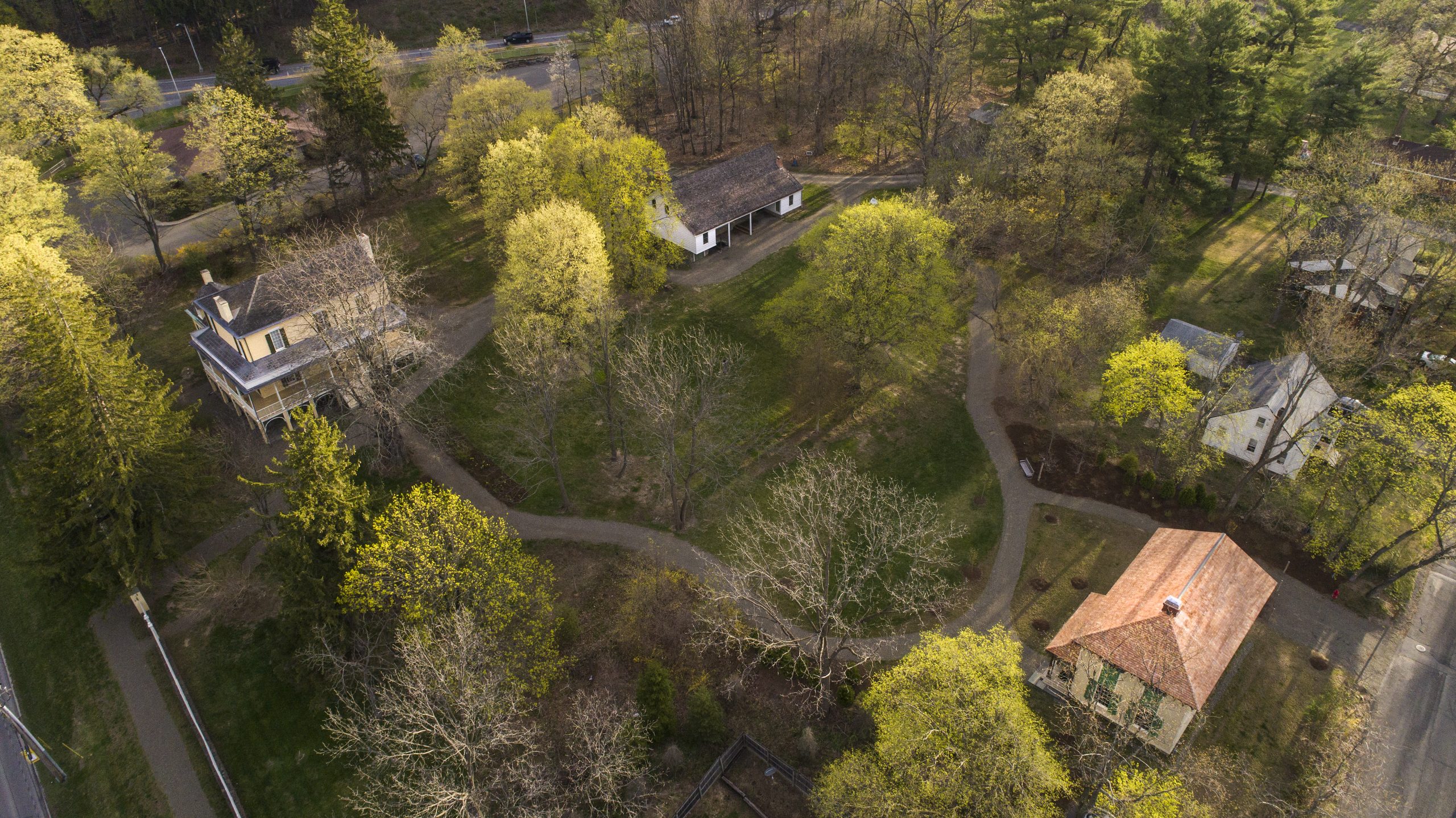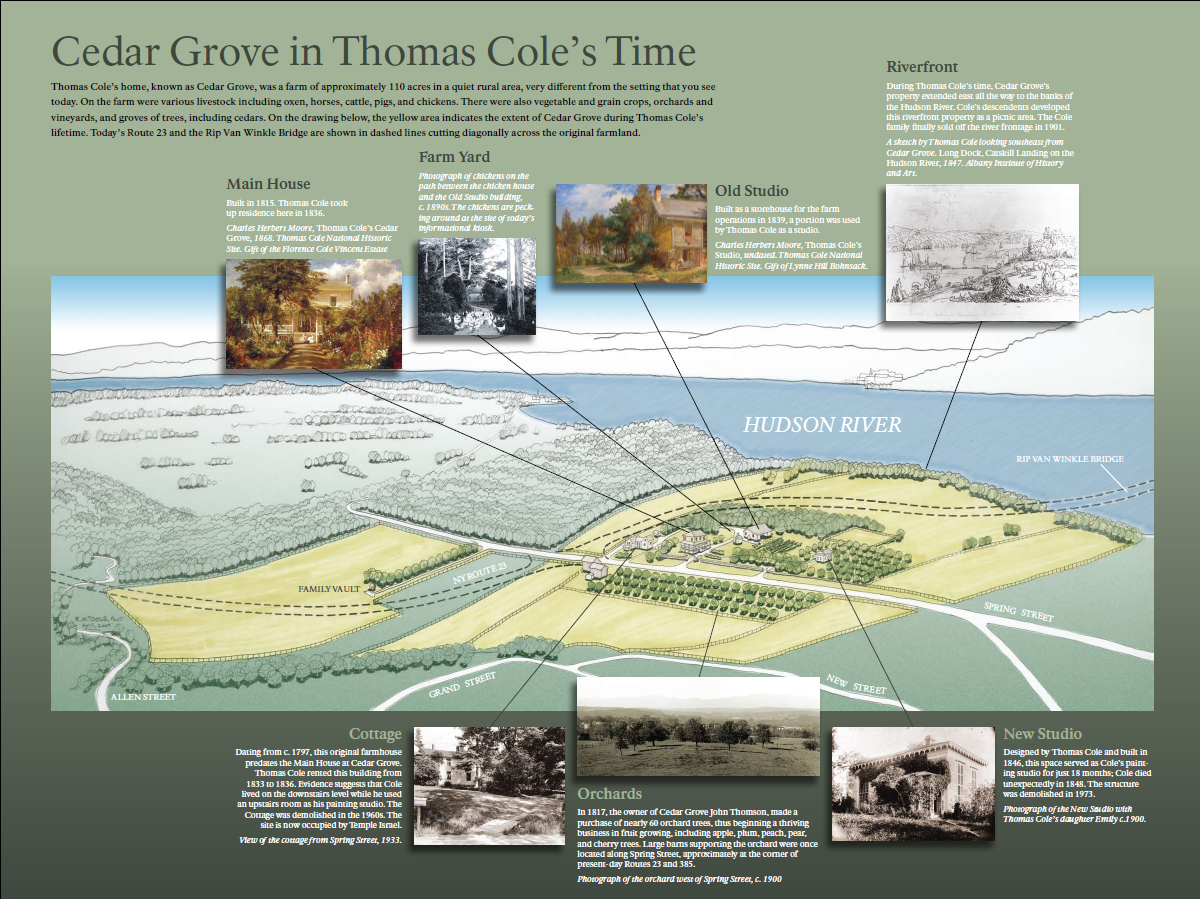Homelands of the Muh-he-conneok
The Thomas Cole National Historic Site is located on the ancestral homelands of the Muh-he-conneok: the People of the Waters That Are Never Still. Today, they are known as the Stockbridge-Munsee Band of Mohican Indians. The tribe is made up of Mohican and Munsee people and is one of 574 federally recognized Tribes in the United States. Today, as a result of European colonization, the Stockbridge-Munsee reservation is in northeast Wisconsin. Despite having been forced from its Hudson Valley homelands, the Stockbridge-Munsee Community remains active both here in the Northeast homelands and in Wisconsin.
(Adapted from the Stockbridge-Munsee Band of Mohican Indians website. Read more at mohican.com.)
Thomson, Bartow, and Cole Families
A family by the name of Thomson bought this property in 1787, and began the establishment of a homestead by 1814 with their nieces, the Bartow sisters. They called it “Cedar Grove.” The Main House and infrastructure were built along a local turnpike road – today’s Spring Street – that crossed through the western portion of the property. During Thomas Cole’s residency, (1836-48), the property consisted of 110 acres. A salaried farmer, domestic laborers, and members of the family tended the plants and animals, and protected the site. Fruit and saleable crops were grown, and a variety of livestock were kept. This place remained in the hands of the Cole family until the 1970s. Although Thomas Cole came to love Cedar Grove for its beauty and its views of the Catskill Mountains, his involvement with running the family farm was minimal, with only a few references to it in his extensive correspondence and journal entries. He occasionally mentioned the grove of trees east of the house, and he referred several times to the flower garden south of the house, but his primary occupation continued to be his art.
Today
As the stewards at a national historic site and museum, we work to restore, maintain, and honor the history of this place. We are guided by ecological principles of supporting biodiversity, reducing the use of toxic materials, replanting traditional plants, and affording a place where people can consider their own relationship and connection with the natural world.
Read more at http://thomascole.org/biodiversity/.
Historic Features:
Flower Garden
The formal garden was restored in 2002, and consists of two flowerbeds flanking a central gravel path that is aligned with the front door of the Main House. Maria Bartow (who married Thomas Cole) and her sisters tended the garden, and period accounts describe it containing a variety of flowers, including hollyhocks, larkspur, poppies, roses, china asters, dahlia, and valerian. A massive honey locust tree, planted when the house was built nearly 200 years ago, anchors the garden.
Honey Locust and Orchard Trees
In autumn 1817, John A. Thomson (who initiated the building of the house with his siblings) ordered a wide variety of fruit trees, enough to plant a sizable orchard of about 80 trees. The 1817 nursery order included fifteen varieties of apples, four varieties of plums, five of peaches, five of pears, and three varieties of cherries. Most notable for us now in this tree order was the inclusion of “12 three thorned acatia (sic).” Today, the acacia is called honey locust (Gleditsia tricanthus) with its distinctive three-branched thorns. A large specimen of this tree continues to grow close to the front porch of the house. If this tree is indeed one of the twelve planted in 1817, it is now over 200 years old.
Kitchen Garden
An extensive kitchen garden was located along the south side of the Storehouse. Originally a quarter acre in size, it was cultivated with a wide variety of vegetables, bush fruit, and grape vines. A small portion of it has now been restored. In 2024, we are partnering with Lucy Grignon (an enrolled member of the Stockbridge-Munsee Band of Mohican Indians and a direct descendant of the Menominee Nation) of Ancient Roots Homestead to honor the land on which the museum sits by replanting Native plants, and reframing out connection with plants and all living things. Feel free to enter and look around!
Woodlot (and Woodland Path)
At one time the Woodlot encompassed about four acres of mixed trees that were periodically thinned for firewood. Following the picturesque style, it was kept rough and unmanicured. Paths and wagon drives led through the woodlot to open fields and Cedar Grove’s frontage on the Hudson River. About one acre of woods remains today on the east end of the historic site. As part of your visit, take a stroll along the Woodland Path!
How to Explore
The Grounds are open for exploration every day from dawn until dusk.
Reference: Toole, Robert M. and Heritage Partners, Cultural Landscape Report for the Thomas Cole National Historic Site: Cedar Grove, Catskill New York, 2004.


